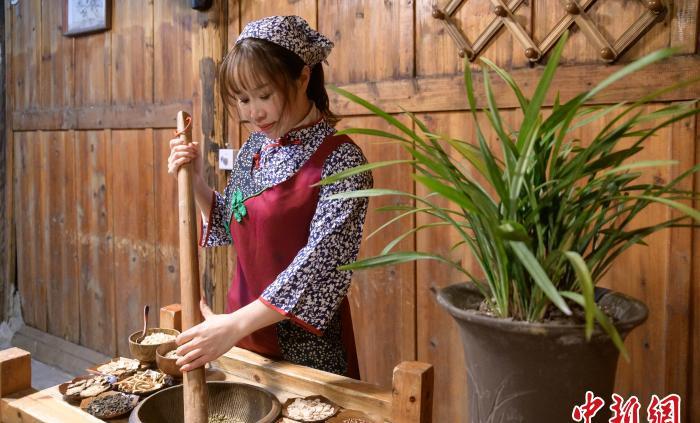
"Post-80s" tea maker Li Hua is making Hakka tea. Photo by Li Nanxuan
(New Year to the grassroots) "post-80s" Hakka women open a teahouse: a wisp of nostalgia and a wisp of love
Sanming, Fujian, China News Network, January 31 (Ye Qiuyun) "Drinking tea, there must be many people. In Futang Lane, Taining County, Sanming City, Fujian Province, the sound of sticks grinding herbs in bowls echoes endlessly, and Li Hua, a Hakka woman after the 80s, is holding a stick to make tea while explaining Hakka tea to diners.
As a valuable wealth left by the Hakka people in the migration from the Central Plains to the south, Huangcha is known as "one of the living fossils of Chinese tea culture". According to historical records, tea was popular in the Central Plains as early as the Song Dynasty. In the colorful food culture of the Hakka, tea is the most representative delicacy, and the production method is simple and elegant, which fully demonstrates the inheritance of the Hakka family to the traditional culture of the Han people.
"Go to the east house, run to the west house, drink tea, play haha, come and go to the family." As the folk song sings, in Fujian Sanming, Longyan and other areas where Hakka people live, hospitable Hakka people are known to beat tea to entertain guests, whether it is a wedding celebration, or relatives and friends visit, that is, please drink tea. In Taining, tea has been a thousand-year-old tradition.
Pictured: white peony, poria, Sichuan dome, angelica, tea, sesame, peanuts and other raw materials. Photo by Li Nanxuan
The Hakka made tea and were known for their women. Li Hua is a tea wrestler in Taining County, running the "Shangpinyuan" tea house.
In the teahouse, white peony, poria, Sichuan dome, angelica, tea, sesame and other raw materials were put into the bowl, and Li Hua grasped the stick and began to grind. The stick is regularly milled along the inner wall of the bowl along the groove, and occasionally it is beaten, and after a while the various raw materials are ground into a powder. Subsequently, Li Hua added water to the bowl and continued to grind, instantly overflowing with medicinal aromas, tea aromas, and sesame seeds, and the longer the beating, the stronger the fragrance. A bowl of refreshing and delicious tea is thus made.
"You can mix it with broth or you can add raw tea oil." Li Hua said with a smile that after the process of beating, the tea oil will become ripe. The taste of meat tea is salty, that kind of light salty taste, drink more bowls without fear of being stung.
Li Hua was born in Dalong Township, Taining County, where most of the people living there were Hakka families. She recalled that when she was a child, there were happy events in the family, or there were distinguished guests visiting the family, or the mother urged milk, so that she could drink tea. "Since I was a child, I have loved to drink tea, and when my grandmother and mother made tea, I watched from the side, and later, naturally, I would do it."
Li Hua, a tea maker, scoops out the prepared Hakka tea with a spoon. Photo by Li Nanxuan
As she grew older, she moved from the countryside to the county seat to work. "That bowl of tea is something I've always remembered in my heart." Li Hua said that the ingredients of the tea are not the same, the taste is different; everyone who makes the tea is different, and the taste will be different.
Thinking about the taste of the bowl of tea, Li Hua began to plan to open the tea house. Li Hua told reporters that at that time, there were very few teahouses in Taining County; opening tea houses in tourist attractions was a kind of inheritance of his traditional Hakka culture.
Made Hakka tea. Photo by Li Nanxuan
In 2015, Li Hua found an old mansion with a history of 200 to 300 years in Futang Lane and was deeply attracted by this antique courtyard. "It's a great match for tea." Her teahouse also took root in this old mansion.
In the view of Huang Xiaorong, deputy director of the Taining County Bureau of Culture, Sports and Tourism, the raw materials used in Taining Tea are tea, peanuts, sesame seeds, tangerine peel, calamus, honeysuckle, licorice, etc. The brewed tea soup is white in color and fragrant in taste, which not only maintains the tea making process and health care function of traditional tea, but also abandons the bitterness or greasiness of folk tea.
Li Hua is tasting his own Hakka tea. Photo by Li Nanxuan
In the ancient city of Taining, drink a bowl of tea and listen to a Merlin play, have a lot of fun. In Futang Lane, Shang Shudi has become one of the must-visit attractions for tourists at home and abroad to come to Taining, and Li Hua's tea house is also favored by tourists.
At the beginning of last year, the sudden outbreak of new crown pneumonia caught Li Hua off guard. It wasn't until after April last year that Li Hua's teahouse opened, "Affected by the epidemic, tourists have decreased a lot, and the turnover has also decreased compared with previous years." ”
Now, the Spring Festival is approaching, Li Hua is looking forward to the early passage of the epidemic, and more foreign tourists come to Taining for tourism. "I also want to improve the tea to suit the tastes of all kinds of people, so that more people can drink a bowl of Taining tea." (End)
Source: China News Network